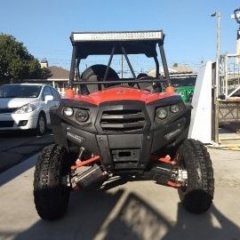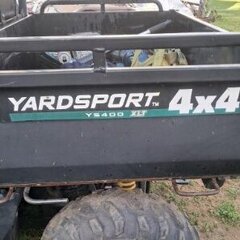Hisun CV Belt replacement
-
Similar Topics
-
By darth vadner
I have a 2019 hi sun 750 I parked it in my garage last fall and about a month later I went to ride it and I had no power but the battery shows good. I’ve taken the ignition switch out and cleaned it. I cleaned the battery terminals and replace the main relay all my fuses are good. I still show strong battery but get no power, can anyone help or have any ideas? I have yet to find any wires chewed up like from a mouse or anything all the wiring looks good.
-
By didgeridoo
Hello, All! I've decided to replace the traction batteries in my 2018 Sector E1 with a 48V Lithium set. They may be expensive, but I figure the Discovery Dry Cell are, too. I am not looking for the max driving range, as I have never received near the brochured range to begin with, but a good mix of charge/ get work done/ charge is what I am expecting.
I have settled on the 48V EAGL kit from bigbattery dot com. Each battery pack provides 30Ah. The kit ships with a charger, as well. The packs would be physically connected in parallel (using a busbar) to one another, maintaining the 48V voltage, but together would be able to provide the amp draw the buggy pulls when going up hill or towing a rake (rated 320 max continuous Amps). This is in comparison to the serial connection the eight 6V lead batteries. Each of the EAGL batteries looks to have its own BMS; am I correct in thinking I will have to use their included charger rather than (simply) changing the onboard charger to lithium mode? The chemistry of the pack is LiFe PO4, for what it's worth. I haven't torn anything apart yet (to diagram), so I am not sure how the dash will interpret the AMP draw, but the kit I am looking at includes a dash mounted charge indicator.
If anyone has completed a similar conversion, do you have any tips? Specifically, how did you remove the original batteries, and how did you secure the new ones? I am guessing that almost any change from the stock batteries would involve at least some modifications. Any tips would be appreciated, especially things I may have failed to consider. Thanks!
-
By BuggyBoy
So these Giant 48v/110ah batteries have just become available: https://www.aussiebatteries.com.au/giant-100ah-48v-lithium-golf-cart-deep-cycle-battery
They look like they could drop in either side of the Controller that sits in the middle of the tray as they are 330mm(W) 355(L) 295mm(H). They can be paralleled, and I think two should be enough. Technically once paralleled the system should output 400ah continuous and 800ah Max (5 secs), more than enough for the E1 - probably 1/3rd more than is needed.
However, the sales person stated that if the regen braking exceeded 400amps, it would put the batteries in standby mode for protection and they would have to be 're-started' with a jumper pack to reset them. Does anybody know the max output of the E1 Regen system, and if it does exceed that, is it possible to disable/bypass the regen so it has a zero output?
Thanks.
-
By BernieG
I could really use some help identifying some disconnected components on a Yard Sport YS400. The first part is this pipe, which comes out of the exhaust port area or the cylinder. It looks like it had a piece of rubber hose on it, but the hose is gone, and I have no idea what it was previously connected to.
The second item is this vacuum valve looking thing. Again only one line is still attached. What is it's function and what other lines should be connected to it?
The last thing is this hose, which exits the side top of the fuel tank (not the fuel line hose) but is not connected to anything
Any help the community could provide would be greatly appreciated. This UTV belongs to a friend, and I am trying to help him get it running correctly for his kids.
-
By Pop Bob
After 10 hours of use, my machine had developed a low speed brake squeal. I removed the brake assembly and discovered that everything was put together dry. Not even lubrication on the caliper pins. After lubricating and reassembly, the squeal has disappeared. I will do the other three wheels today. Also, all grease fittings were under-greased (if at all) based on the amount of grease filled before they purged. This includes the drivelines. Next- I found many screws which were loose and/or stripped. I was able to tighten or fix them with my tap and die set. The lower a-arms on the front do not have grease zerks. I will remove the arms and install some. I guess I’m not surprised or even disappointed. These are just things that should be looked at on any machine. One thing I am pissed about though, is this “weld from hell” on the front . Totally unacceptable. For sure there will be water entry and eventual internal rust.
(see photo) I will fix it. I did an oil and filter change which some of you will say was not necessary. But break-in time is when you are most likely to have contamination from production and initial wear-in. BTW there was some metal in the filter. Cheap insurance to change often. Engine access is very difficult on this machine compared to other models. You have to remove lots of stuff to get to it. But I still like the machine very much, and I’m having a ball with it. Future plans include lights, cab enclosure and heater. Winters are long in Northern Michigan.
PB
-







Recommended Posts
Join the conversation
You can post now and register later. If you have an account, sign in now to post with your account.
Note: Your post will require moderator approval before it will be visible.